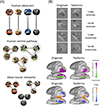Does the brain's ventral visual pathway compute object shape?
- PMID: 36272937
- PMCID: PMC11669366
- DOI: 10.1016/j.tics.2022.09.019
Does the brain's ventral visual pathway compute object shape?
Abstract
A rich behavioral literature has shown that human object recognition is supported by a representation of shape that is tolerant to variations in an object's appearance. Such 'global' shape representations are achieved by describing objects via the spatial arrangement of their local features, or structure, rather than by the appearance of the features themselves. However, accumulating evidence suggests that the ventral visual pathway - the primary substrate underlying object recognition - may not represent global shape. Instead, ventral representations may be better described as a basis set of local image features. We suggest that this evidence forces a reevaluation of the role of the ventral pathway in object perception and posits a broader network for shape perception that encompasses contributions from the dorsal pathway.
Keywords: deep neural networks; dorsal stream; object recognition; shape perception; ventral stream; viewpoint-invariance.
Copyright © 2022 Elsevier Ltd. All rights reserved.
Conflict of interest statement
Declaration of interests No interests are declared.
Figures




References
-
- Wagemans J et al. (2008) Identification of everyday objects on the basis of silhouette and outline versions. Perception 37, 207–244 - PubMed
-
- Elder JH and Velisavljević L (2009) Cue dynamics underlying rapid detection of animals in natural scenes. J. Vision 9, 1–20 - PubMed
-
- Biederman I and Ju G (1988) Surface versus edge-based determinants of visual recognition. Cogn. Psychol. 20, 38–64 - PubMed
-
- Quinn PC et al. (2001) Perceptual categorization of cat and dog silhouettes by 3-to 4-month-old infants. J. Exp. Child Psychol. 79, 78–94 - PubMed
Publication types
MeSH terms
Grants and funding
LinkOut - more resources
Full Text Sources

